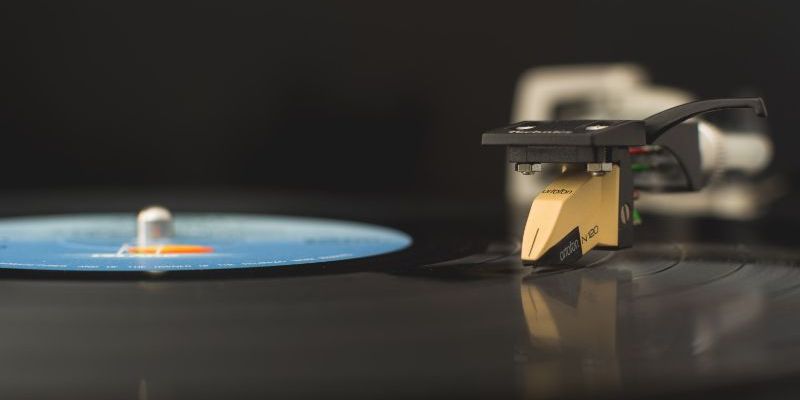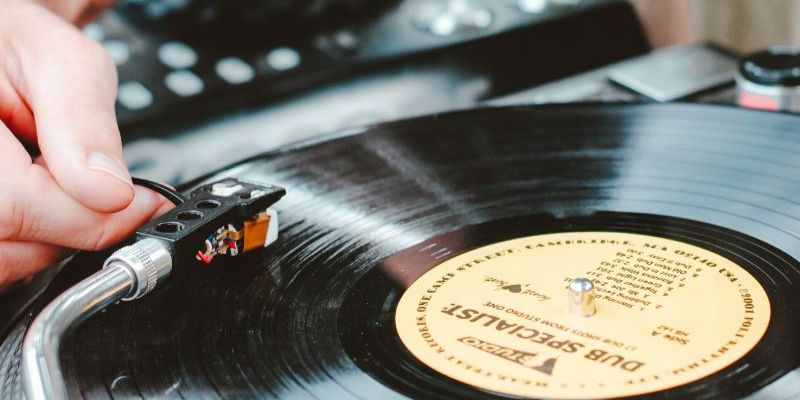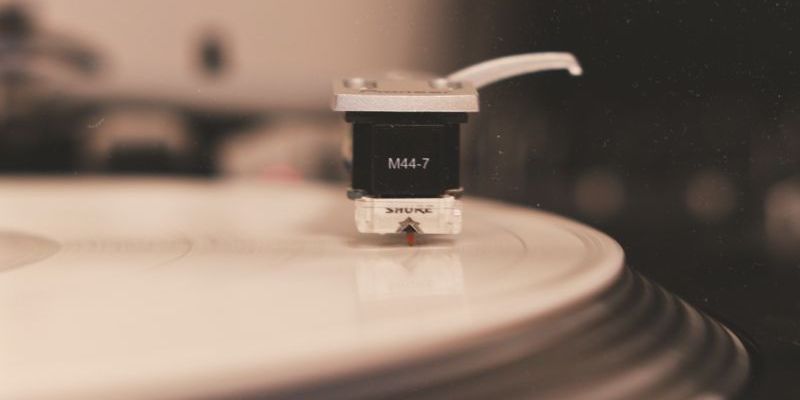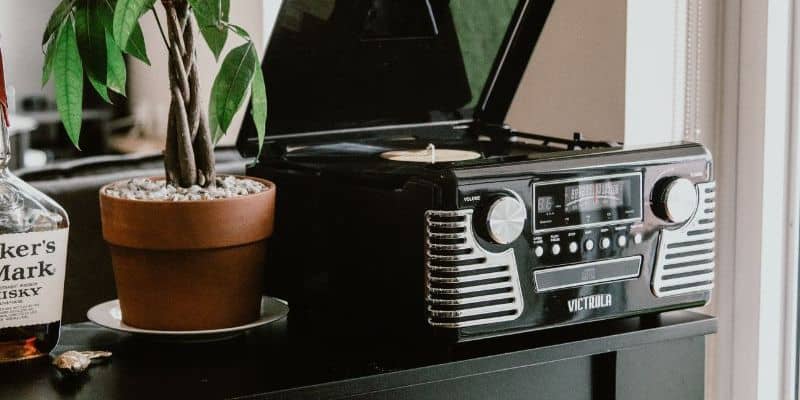
What Is A Tonearm?
The point and function of a tonearm in layman’s terms is to guide the stylus across the vinyl grooves and relay this back through the cartridge and wires via waves to ensure your tunes get played at the best possible quality.
In more technical terms, the function of the tonearm is to support the cartridge going around the record and towards the centre. While aiding this movement, the tonearm must maintain a stable position above the record for the cartridge to trace the groove effectively. It means maintaining a level height and angle.
The tonearm needs to figure out how to apply the right amount of weight to the stylus and determine how effective the anti-skate force is to prevent the cartridge from flying towards the middle. It carries the wires that transmit the waves and turn the vinyl grooves into sweet music. And you thought record players were simple; here’s how record players work.
Tonearms seemingly look and feel like they are just a bit of plastic which merely moves the stylus, but this intricate component of the vinyl player is crucial to getting the best functionality and sound out of your turntable.
Why Are Tonearms Important?
Tonearms have such an impact on how your cartridge works and how your music sounds. They offer a perfect way to optimise your turntable with the arms mass, rigidity, material and bearing, all playing a massive role in how the cartridge interacts with the vinyl and ultimately the way the vinyl sounds.
Where Are Tonearms Located?
Tonearms are the bit on automatic vinyl that moves across and places the stylus on the record when it starts spinning. On Manual record players, you need to move the tonearm yourself across from a resting position to the start of the vinyl and back again when finished. The beauty of manual record players is their customisability, and tonearms can play a huge role.
What Are Tonearms Made From?
Most, not all, tonearms are made from metal – commonly aluminium or magnesium. Some are made from wood or plastic, but this generally is not the case. All tonearms will be based on a pivot of some sort.
Usually, nowadays, tonearms are on a gimbal bearing arrangement whereby they move in both vertical and horizontal fashion, just like record players themselves. The metal in these components make them sturdy and increase their longevity whilst also acting as the best functional material for this part.
Types Of Tonearms
When it comes to what tonearm is the best, you have a bit of a selection on your hands. Not only do you need to work out what the best style of tonearm suits you, but you also want to consider what type of pivot your tonearms are on. The differences in these options change the way your turntable operates and sounds.
When it comes to the style of the tonearm, there are three main ones to choose from: Straight type, J-type and S-type. Some swear that there are differences in how they operate from manoeuvrability to the number of vibrations created, but there is very little difference in performance between the 3.
The style of tonearm which you are using has no bearing on the quality of sound you are getting from your vinyl. It is all about the angle and direction with which the tonearm is resting the cartridge. And this comes down to the bearing that you are opting for. Now, the bearing or pivot choice does matter.
Types Of Pivot
How the actual tonearm is set up is almost as important as the arms performance itself. There are three main types of tonearm pivots which you will encounter throughout your vinyl career.
Gimbal Tonearm
The gimbal tonearm is the most common type of tonearm. It is tried and tested to work effectively. Working well to produce consistent sound, it is easy to set up and cheap. The design and performance of a Gimbal tonearm can be fragmented and problematic at times – it’s worth remembering this. The tonearm naturally provides more friction which can cause tracking errors.
- Benefits of the Gimbal tonearms – easily accessible
- Disadvantages of the Gimbal tonearms – prone to friction issues
The Uni-Pivot Tonearm
These tonearms are heading towards being reasonably pricey, but they are excellent options of tonearms if you are willing to invest. They will eliminate almost all the friction and tracing issues you may face with other tonearms. With the pivot used in these tonearms, you don’t need to worry about the bearing working or not. The issue with these tonearms is that they are often harder to set up whilst also being a bit more flimsy, which is off-putting for many.
- Benefits of Uni-Pivot Tonearms – Don’t need to worry about the angle of the bearing
- Disadvantages of Uni-Pivot Tonearms – Tricky to set up
Linear Track Tonearm
These are without a doubt the best tonearms in terms of high-fidelity performance. They will create an excellent sound free from errors or vibrations, but these tonearms are extremely hard to set up and often super-pricey. These arms will also require a lot of maintenance to keep them at the top of their game, but it will be worth it for the crisp sounds that they offer in return.
- Benefits of Linear Track Tonearms – Exquisite sound
- Disadvantages of Linear Track Tonearms – Pricey

The Challenges Of A Tonearm
The main challenge for tonearms is sorting out the best balance performance for your listening experience. Striking a balance with your tonearm will lead to stronger tracing, fewer vibrations and ultimately a much better sounding vinyl.
Companies are continuing to present innovative ways to develop their tonearms to strike this balance as best as they can. This ranges from carbon fibre materials to uni-pivotal bearing points. The beauty of the record player is its customisability.
The Technicalities Of A Tonearm And How To Balance Them Perfectly For The Best Sound
Whilst it is a bit technical and sounds like a chore, setting the tracking weight, and cartridge weight on your tonearm is pivotal for getting the most from your tonearm. Knowing the steps to this can help you get the most from your tonearm and your record player and helps reduce friction and tracing issues – ultimately allowing you to have the best bop possible. So what are the steps?
- No Skating allowed – turn it off
- Set that yoke up – be sure not to let the arm smash down onto the vinyl
- Make sure you are even stevens – level the arm
- Dial-up that bad boy to zero – adjust the arm tracking weight dial to zero
- Speak the weight – set the counterweight to balance the tonearm
- Stick that skating right back on – reset the anti-skating control
Now it’s time to sit back, relax and listen. You’re either going to have perfected it or be facing a bit of a broken vinyl.

Design And Aesthetic
Ultimately the design, aesthetic value and manufacturing of a tonearm will come down to personal preference and whilst some will eliminate sound issues, tonearms come down to personal preference. Perhaps the best example of this is the style of tonearm you opt for, whether it be J-type or S-type.
Knowing which pros and cons suit you and knowing how much time and money you are willing to invest in your record player is the best place to start when it comes to vinyl in general. No doubt you want your setup to look good as well, so it’s a worthy consideration.
Tonearms Are All About Balance
Choosing the right record player is potentially more challenging than ever before with such a selection on the market, but if you figure out what is best for you, you are onto a winner. Getting the right balance on your tonearms for the best price and best suited for your record player is what the hobby is all about. But it can be a minefield sometimes.
We hope that this has created some clarity around tonearms for you to transfer straight into getting the most clarity out of your vinyl from a top-class tonearm.








